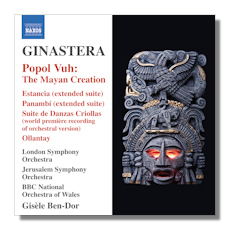
The Internet's Premier Classical Music Source
Related Links
- Ginastera Reviews
- Latest Reviews
- More Reviews
-
By Composer
-
Collections
DVD & Blu-ray
Books
Concert Reviews
Articles/Interviews
Software
Audio
Search Amazon
Recommended Links
Site News
 CD Review
CD Review
Alberto Ginastera

- Estancia, Op. 8 (extended suite)
- Suite de Danzas Criollas, Op. 15 (orch. Cohen) *
- Panambi, Op. 1 (extended suite)
- Ollantay, Op. 17 **
- Popul Vuh: The Mayan Creation, Op. 44 **
London Symphony Orchestra/Gisèle Ben-Dor
* Jerusalem Symphony Orchestra/Gisèle Ben-Dor
** BBC National Orchestra of Wales/Gisèle Ben-Dor
Naxos 8.570999 72:51
Summary for the Busy Executive: Gauchos, Indians, and gods.
Ginastera didn't write much, but most of his output has become part of the repertory. After a brief, quasi-Impressionist phase, he entered a Bartókian nationalist period, from which come his most popular works. In the Fifties, he began to move with postwar currents without losing his own voice. The last movement of the dodecaphonic Piano Concerto #1 actually became a cross-over hit for the arty rock band Emerson, Lake, and Palmer. As Ginastera proceeded, however, he became more and more the property of the new-music crowd. The nationalist elements grew more and more sublimated and abstract. In his last works, however, he became inspired by pre-Columbian native cultures – Incan, Mayan, Aztec, and so on.
The Panambi and Estancia suites are not the ones made by the composer, but adapted by, I assume, Ben-Dor. They include more music, which is all to the good. I also assume that Naxos has taken these from Ben-Dor's recording of the complete ballets (Naxos 8.557582). I prefer the full scores to the suites, because you get all the music from two of Ginastera's most dynamic pieces. Panambi reveals traces of Stravinsky's Firebird, while Estancia transposes Bartók to the Argentine pampas. Ben-Dor leads super-charged performances with the London Symphony, simply one of the great orchestras in the world. There's a bit of rhythmic raggedness in the background parts of the Estancia suite's first movement, but I noticed it only on my third close listening.
The Suite de Danzas Criollas, originally for piano, appears here in an orchestration by Shimon Cohen. It's a capable job, but it doesn't sound to me like Ginastera's orchestra. It's clearer and lighter than the sound the composer normally produces. I miss his muscle. The music, however, delights. It opens with an expansive, wistful song, with the harp imitating an accompanying guitar. A super-malambo follows, overwhelming and over in half-a-minute. A love song leads to what sounds like a meditation on the loneliness of the Argentinean plains. Ginastera rounds off the suite with a stamping, macho dance, reminiscent in spots of Copland's Rodeo. Orchestrator Cohen rises to the challenge here and gets the authentic Ginastera sound. For those of you who might be interested in the piano original, Barbara Nissman on Pierian 05/6 stands out from everybody else, and you get the complete piano chamber music besides.
Inca myth inspired Ollantay, designated by the composer as "Tres movimientos sinfónicos" and usually in English as "A Symphonic Triptych." It premiered under the baton of Erich Kleiber. The score falls between two stools. Lacking symphonic argument, it's not a symphony and much too sketchy for a ballet. I guess you'd call it a tone poem, but unlike, for example, Strauss's Don Quixote, it doesn't mickey-mouse the plot. The first movement evokes the Andes with the lonely sound of a solo Indian flute. This builds to big statements depicting the majesty and grandeur of the mountains themselves. The second movement, "The Warriors," as you might expect, gives us war music, as Ollantay's hosts ritually prepare for a battle with the forces of the Sun. The music may remind you of the wilder parts of Stravinsky's Rite of Spring. The finale, "The Death of Ollantay," anguishes over the hero's death and prophecy of the destruction of Sun's empire. The music subsides to the opening mood, and after one final outburst, fades out.
The Aztec creation myth, Popul Vuh, occupied Ginastera for decades. Eugene Ormandy commissioned him in the Fifties, and Ginastera left the score with the last of its eight sections partially incomplete when he died in 1983. So much time had passed, however, that the score for all practical purposes had dropped down a hole. Ginastera champion Barbara Nissman brought it to the attention of Leonard Slatkin, who premiered it 1989. In the way it works, it resembles Ollantay – a tone poem for the imagination. Unlike that earlier score, it has few recognizable themes. Instead, it proceeds by color. The piccolo evokes the ancient Aztec culture, the kettledrums the deep forces of the world. The creation turns out to have had its violent moments. We proceed from chaos, to earth, to animals, to the means of life, to humans, to at last a celebration of the heavens. The sounds are both gorgeous and fascinating, and in some mysterious way, Ginastera links them together convincingly. For me, this is the outstanding score on the disc, though your mileage may vary. I think it may well be the composer's masterpiece, finished or not.
Ben-Dor proved her Ginastera chops in her earlier releases of the popular ballets and of the Variaciones concertantes and the Glosses on Themes of Pablo Casals. She gets great playing not only from the LSO, but from every one of her ensembles. Her Popul Vuh especially impressed me, since it's a hard score to keep together, and she makes the music both coherent and exciting. The sound is excellent.
Copyright © 2012, Steve Schwartz.





















